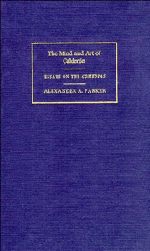Book contents
- Frontmatter
- Contents
- Author's preface
- Editor's preface
- Introduction
- I Stylistic and dramatic craftsmanship
- II From experience to myth
- III The tensions of social life
- IV The tensions of public life
- 18 The king as centre of political life
- 19 Religion and the state: La cisma de Ingalaterra
- 20 The issue of religious freedom
- 21 Religion and war: El príncipe constante
- 22 The drama as commentary on public affairs
- V From symbol to myth
- Epilogue
- Notes
- Index
22 - The drama as commentary on public affairs
Published online by Cambridge University Press: 05 February 2012
- Frontmatter
- Contents
- Author's preface
- Editor's preface
- Introduction
- I Stylistic and dramatic craftsmanship
- II From experience to myth
- III The tensions of social life
- IV The tensions of public life
- 18 The king as centre of political life
- 19 Religion and the state: La cisma de Ingalaterra
- 20 The issue of religious freedom
- 21 Religion and war: El príncipe constante
- 22 The drama as commentary on public affairs
- V From symbol to myth
- Epilogue
- Notes
- Index
Summary
Las armas de la hermosuraand the Catalan Rebellion (1640–52)
At the commencement of his dramatic career, as has been seen, Calderón raised politico-religious issues that had been prominent in recent events. These provided a ‘historical context’ for dramatic plots, and no well-informed member of the audience (which would have included king and councillors) should have failed to see the analogies. But apart from the general implication in the plays that have already been considered, namely, that conciliation and peace are likely to prove more successful than intransigence and war, none of these plays can be taken as ‘speaking without telling’ in Bances Candamo's sense. There are, however, two plays that may clearly come into this category.
The first is Las armas de la hermosura, and its source play, El privilegio de las mujeres. The former was analysed in chapter 5 as an example of the dramatic requirement to transform ‘historical truth’ into ‘poetic truth’. The analysis and the interpretations of the play previously given still stand, but the theme of pardon instead of vengeance and the restoration of privileges has a special application to the aftermath of the Revolt of Catalonia, which lasted from 1640 to 1652.
The causes of the Revolt lay in the ‘regionalist’ structure of the Spanish State, so different from the centralisation that had been achieved in France. Regionalism versus centralisation was to remain a perennial Spanish problem, as the new democratic state that succeeded the dictatorship of General Franco eventually conceded.
- Type
- Chapter
- Information
- The Mind and Art of CalderónEssays on the Comedias, pp. 312 - 326Publisher: Cambridge University PressPrint publication year: 1989

